Quantifying the Spatial Integration Patterns of Urban Agglomerations along an Inter-City Gradient
Abstract
1. Introduction
2. Study Area and Data
2.1. Study Area
2.2. Data Pre-Processing
3. Methodology
3.1. Framework
3.2. Qualitative Analysis of Urban Expansion
3.3. Landscape Metrics
3.4. Radar Graph Analysis
3.5. Hierarchical Cluster Analysis
4. Results
4.1. Dynamic Changes of Urban Expansion at the Regional Level from 1995–2015
4.2. Spatial Heterogeneity Characteristics at the Prefectural Level
4.3. Landscape Variations along Urban-Green Core-Urban Gradient Transects
4.4. Urban Functional Zones along Urban-Green Core-Urban Gradient Transects
5. Discussion
6. Conclusions
Author Contributions
Funding
Conflicts of Interest
References
- United Nations. World Urbanization Prospects, the 2018 Revision; United Nations: New York, NY, USA, 2017. [Google Scholar]
- Li, S.; Liu, X.; Li, Z.; Wu, Z.; Yan, Z.; Chen, Y.; Gao, F. Spatial and Temporal Dynamics of Urban Expansion along the Guangzhou–Foshan Inter-City Rail Transit Corridor, China. Sustainability 2018, 10, 593. [Google Scholar] [CrossRef]
- Thapa, R.B.; Murayama, Y. Examining Spatiotemporal Urbanization Patterns in Kathmandu Valley, Nepal: Remote Sensing and Spatial Metrics Approaches. Remote Sens. 2009, 1, 534–556. [Google Scholar] [CrossRef]
- Fang, C.; Yu, D. Urban Agglomeration: An Evolving Concept of an Emerging Phenomenon. Landsc. Urban Plan. 2017, 162, 126–136. [Google Scholar] [CrossRef]
- Liu, Y.; Zhou, G.; Liu, D.; Yu, H.; Zhu, L.; Zhang, J. The Interaction of Population, Industry and Land in Process of Urbanization in China: A Case Study in Jilin Province. Chin. Geogr. Sci. 2018, 28, 529–542. [Google Scholar] [CrossRef]
- Deng, X.; Huang, J.; Rozelle, S.; Uchida, E. Growth, Population and Industrialization, and Urban Land Expansion of China. J. Urban Econ. 2008, 63, 96–115. [Google Scholar] [CrossRef]
- Marshall, J.D. Urban Land Area and Population Growth: A New Scaling Relationship for Metropolitan Expansion. Urban Stud. 2007, 44, 1889–1904. [Google Scholar] [CrossRef]
- Weng, Y.C. Spatiotemporal Changes of Landscape Pattern in Response to Urbanization. Landsc. Urban Plan. 2007, 81, 341–353. [Google Scholar] [CrossRef]
- Yeh, C.T.; Huang, S.L. Investigating Spatiotemporal Patterns of Landscape Diversity in Response to Urbanization. Landsc. Urban Plan. 2009, 93, 151–162. [Google Scholar] [CrossRef]
- Deng, J.S.; Wang, K.; Hong, Y.; Qi, J.G. Spatio-Temporal Dynamics and Evolution of Land Use Change and Landscape Pattern in Response to Rapid Urbanization. Landsc. Urban Plan. 2009, 92, 187–198. [Google Scholar] [CrossRef]
- Seto, K.C.; Fragkias, M.; Güneralp, B.; Reilly, M.K. A Meta-Analysis of Global Urban Land Expansion. PLoS ONE 2011, 6, e23777. [Google Scholar] [CrossRef]
- Fang, C.; Liu, H.; Li, G.; Sun, D.; Miao, Z. Estimating the Impact of Urbanization on Air Quality in China Using Spatial Regression Models. Sustainability 2015, 7, 15570–15592. [Google Scholar] [CrossRef]
- Seto, K.C.; Dhakal, S.; Bigio, A.; Blanco, H.; Delgado, G.C.; Dewar, D.; Huang, L.; Inaba, A.; Kansal, A.; Lwasa, S.; et al. Human Settlements, Infrastructure and Spatial Planning. In Climate Change 2014: Mitigation of Climate Change. IPCC Working Group III Contribution to AR5; Cambridge University Press: Cambridge, UK, 2014; Chapter 12. [Google Scholar]
- Burgess, E.W. The Growth of the City: An introduction to a research project. In The City; Park, R.E., Burgess, E.W., McKenzie, R.D., Eds.; University of Chicago Press: Chicago, IL, USA, 1925; pp. 47–62. [Google Scholar]
- Hoyt, H. The Structure and Growth of Residential Neighborhoods in American Cities; Federal Housing Administration: Washington, DC, USA, 1939. [Google Scholar]
- Harris, C.D.; Ullman, E.L. The Nature of Cities. Ann. Am. Acad. Polit. Soc. Sci. 1945, 242, 7–17. [Google Scholar] [CrossRef]
- Gottman, J. Megalopolis: On the Urbanization of the Northeastem Seaboard. Econ. Geogr. 1957, 33, 3. [Google Scholar] [CrossRef]
- López, E.; Bocco, G.; Mendoza, M.; Duhau, E. Predicting Land-Cover and Land-Use Change in the Urban Fringe: A Case in Morelia City, Mexico. Landsc. Urban Plan. 2001, 55, 271–285. [Google Scholar] [CrossRef]
- Yue, W.; Liu, Y.; Fan, P. Measuring Urban Sprawl and Its Drivers in Large Chinese Cities: The Case of Hangzhou. Land Use Policy 2013, 31, 358–370. [Google Scholar] [CrossRef]
- Wu, W.; Zhao, S.; Zhu, C.; Jiang, J. A Comparative Study of Urban Expansion in Beijing, Tianjin and Shijiazhuang over the Past Three Decades. Landsc. Urban Plan. 2015, 134, 93–106. [Google Scholar] [CrossRef]
- Masini, E.; Tomao, A.; Barbati, A.; Corona, P.; Serra, P.; Salvati, L. Urban Growth, Land-use Efficiency and Local Socioeconomic Context: A Comparative Analysis of 417 Metropolitan Regions in Europe. Environ. Manag. 2019, 63, 322–337. [Google Scholar] [CrossRef] [PubMed]
- Seto, K.C.; Kaufmann, R.K. Modeling the Drivers of Urban Land Use Change in the Pearl River Delta, China: Integrating Remote Sensing with Socioeconomic Data. Land Econ. 2003, 79, 106–121. [Google Scholar] [CrossRef]
- Ouyang, T.; Kuang, Y.; Hu, Z.; Sun, B. Urbanization in the Pearl River Delta Economic Zone, China. Int. J. Sustain. Dev. World Ecol. 2005, 12, 48–54. [Google Scholar] [CrossRef]
- Liu, D.; Chen, N. Satellite Monitoring of Urban Land Change in the Middle Yangtze River Basin Urban Agglomeration, China between 2000 and 2016. Remote Sens. 2017, 9, 1086. [Google Scholar] [CrossRef]
- Uszkai, A. Spatial integration and identity: Cases of border regions. J. Glob. Acad. Inst. Educ. Soc. Sci. 2015, 1, 1–13. [Google Scholar]
- Geertman, S.C.; Ritsema Van Eck, J.R. GIS and Models of Accessibility Potential: An Application in Planning. Int. J. Geogr. Inf. Syst. 1995, 9, 67–80. [Google Scholar] [CrossRef]
- He, J.; Li, C.; Yu, Y.; Liu, Y.; Huang, J. Measuring Urban Spatial Interaction in Wuhan Urban Agglomeration, Central China: A Spatially Explicit Approach. Sustain. Cities Soc. 2017, 32, 569–583. [Google Scholar] [CrossRef]
- Alig, R.J.; Healy, R.G. Urban and Built-Up Land Area Changes in the United States: An Empirical Investigation of Determinants. Land Econ. 1987, 63, 215–226. [Google Scholar] [CrossRef]
- Vessali, K.V. Land Use Impacts of Rapid Transit: A Review of the Empirical Literature. Berkeley Plan. J. 1996, 11. [Google Scholar] [CrossRef]
- Munneke, H.J. Dynamics of the Urban Zoning Structure: An Empirical Investigation of Zoning Change. J. Urban Econ. 2005, 58, 455–473. [Google Scholar] [CrossRef]
- Antrop, M.; Van Eetvelde, V. Holistic Aspects of Suburban Landscapes: Visual Image Interpretation and Landscape Metrics. Landsc. Urban Plan. 2000, 50, 43–58. [Google Scholar] [CrossRef]
- Zeng, H.; Wu, X.B. Utilities of Edge-Based Metrics for Studying Landscape Fragmentation. Comput. Environ. Urban Syst. 2005, 29, 159–178. [Google Scholar] [CrossRef]
- Lin, T.; Sun, C.; Li, X.; Zhao, Q.; Zhang, G.; Ge, R.; Ye, H.; Huang, N.; Yin, K. Spatial Pattern of Urban Functional Landscapes along an Urban–Rural Gradient: A Case Study in Xiamen City, China. Int. J. Appl. Earth Obs. Geoinf. 2016, 46, 22–30. [Google Scholar] [CrossRef]
- Wu, H.; Li, Z.; Clarke, K.C.; Shi, W.; Fang, L.; Lin, A.; Zhou, J. Examining the Sensitivity of Spatial Scale in Cellular Automata Markov Chain Simulation of Land Use Change. Int. J. Geogr. Inf. Sci. 2019, 33, 1040–1061. [Google Scholar] [CrossRef]
- Xu, X.; Min, X. Quantifying Spatiotemporal Patterns of Urban Expansion in China Using Remote Sensing Data. Cities 2013, 35, 104–113. [Google Scholar] [CrossRef]
- Rode, P.; Floater, G.; Thomopoulos, N.; Docherty, J.; Schwinger, P.; Mahendra, A.; Fang, W. Accessibility in Cities: Transport and Urban Form. In Disrupting Mobility: Impacts of Sharing Economy and Innovative Transportation on Cities; Meyer, G., Shaheen, S., Eds.; Lecture Notes in Mobility; Springer International Publishing: Cham, Switzerland, 2017; pp. 239–273. [Google Scholar] [CrossRef]
- Pan, H.; Zhang, M. Rail Transit Impacts on Land Use: Evidence from Shanghai, China. Transp. Res. Rec. 2008, 2048, 16–25. [Google Scholar] [CrossRef]
- Sung, H.; Oh, J.T. Transit-Oriented Development in a High-Density City: Identifying Its Association with Transit Ridership in Seoul, Korea. Cities 2011, 28, 70–82. [Google Scholar] [CrossRef]
- Knowles, R.D. Transit Oriented Development in Copenhagen, Denmark: From the Finger Plan to restad. J. Transp. Geogr. 2012, 22, 251–261. [Google Scholar] [CrossRef]
- Huang, H. The Land-Use Impacts of Urban Rail Transit Systems. J. Plan. Lit. 1996, 11, 17–30. [Google Scholar] [CrossRef]
- Luck, M.; Wu, J. A Gradient Analysis of Urban Landscape Pattern: A Case Study from the Phoenix Metropolitan Region, Arizona, USA. Landsc. Ecol. 2002, 17, 327–339. [Google Scholar] [CrossRef]
- Cushman, S.A.; Gutzweiler, K.; Evans, J.S.; McGarigal, K. The Gradient Paradigm: A Conceptual and Analytical Framework for Landscape Ecology. In Spatial Complexity, Informatics, and Wildlife Conservation; Cushman, S.A., Huettmann, F., Eds.; Springer: Tokyo, Japan, 2010; pp. 83–108. [Google Scholar] [CrossRef]
- Yu, X.J.; Ng, C.N. Spatial and Temporal Dynamics of Urban Sprawl along Two Urban–Rural Transects: A Case Study of Guangzhou, China. Landsc. Urban Plan. 2007, 79, 96–109. [Google Scholar] [CrossRef]
- Dai, E.; Wang, Y.; Ma, L.; Yin, L.; Wu, Z. ‘Urban-Rural’ Gradient Analysis of Landscape Changes around Cities in Mountainous Regions: A Case Study of the Hengduan Mountain Region in Southwest China. Sustainability 2018, 10, 1019. [Google Scholar] [CrossRef]
- Vizzari, M.; Hilal, M.; Sigura, M.; Antognelli, S.; Joly, D. Urban-Rural-Natural Gradient Analysis with CORINE Data: An Application to the Metropolitan France. Lands. Urban Plan. 2018, 171, 18–29. [Google Scholar] [CrossRef]
- Hunan, S.B.O. Hunan Statistical Yearbook 2017; Technical Repor; China Statistics Press: Changsha, China, 2018. [Google Scholar]
- Li, G.; Sun, S.; Fang, C. The Varying Driving Forces of Urban Expansion in China: Insights from a Spatial-Temporal Analysis. Landsc. Urban Plan. 2018, 174, 63–77. [Google Scholar] [CrossRef]
- Chinese Land Surveying and Planning Institute (CLSPI); Cadastral Management Division of the Ministry of Land and Resources of the People’s Republic of China (CMDMLRRPC). Current Land Use Classification; Standard GB/T 21010-2017; Standardization Administration of China (SAC): Beijing, China, 2017.
- Jat, M.K.; Garg, P.K.; Khare, D. Monitoring and Modelling of Urban Sprawl Using Remote Sensing and GIS Techniques. Int. J. Appl. Earth Obs. Geoinf. 2008, 10, 26–43. [Google Scholar] [CrossRef]
- McGarigal, K.; Cushman, S.; Ene, E. FRAGSTATS v4: Spatial Pattern Analysis Program for Categorical and Continuous Maps. 2012. Available online: http://www.umass.edu/landeco/research/fragstats/fragstats.html (accessed on 15 December 2018).
- Zhang, Q.; Su, S. Determinants of Urban Expansion and Their Relative Importance: A Comparative Analysis of 30 Major Metropolitans in China. Habitat Int. 2016, 58, 89–107. [Google Scholar] [CrossRef]
- Zhu, Z. Spatial Structure of the Changsha–Zhuzhou–Xiangtan Urban Agglomeration Based on Dynamic Simulation Analysis. J. Urban Plan. Dev. 2015, 141, 04014035. [Google Scholar] [CrossRef]
- Dietzel, C.; Oguz, H.; Hemphill, J.J.; Clarke, K.C.; Gazulis, N. Diffusion and Coalescence of the Houston Metropolitan Area: Evidence Supporting a New Urban Theory. Environ. Plan. B Plan. Des. 2005, 32, 231–246. [Google Scholar] [CrossRef]
- Quan, B.; Xiao, Z.; Römkens, M.J.M.; Bai, Y.; Lei, S. Spatiotemporal Urban Land Use Changes in the Changzhutan Region of Hunan Province in China. J. Geogr. Inf. Syst. 2013, 5, 136. [Google Scholar] [CrossRef][Green Version]
- Aljoufie, M.; Zuidgeest, M.; Brussel, M.; van Maarseveen, M. Spatial–Temporal Analysis of Urban Growth and Transportation in Jeddah City, Saudi Arabia. Cities 2013, 31, 57–68. [Google Scholar] [CrossRef]
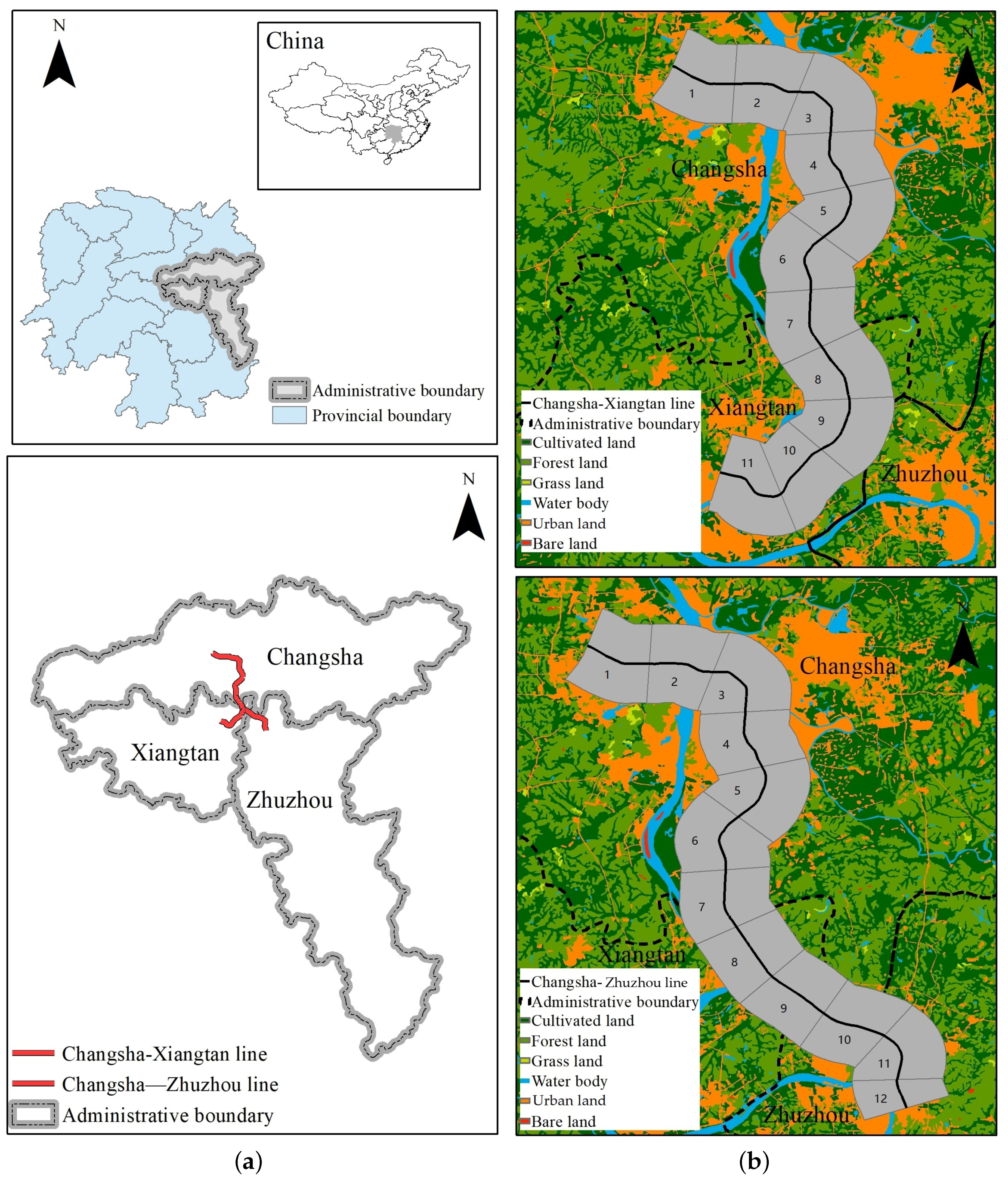
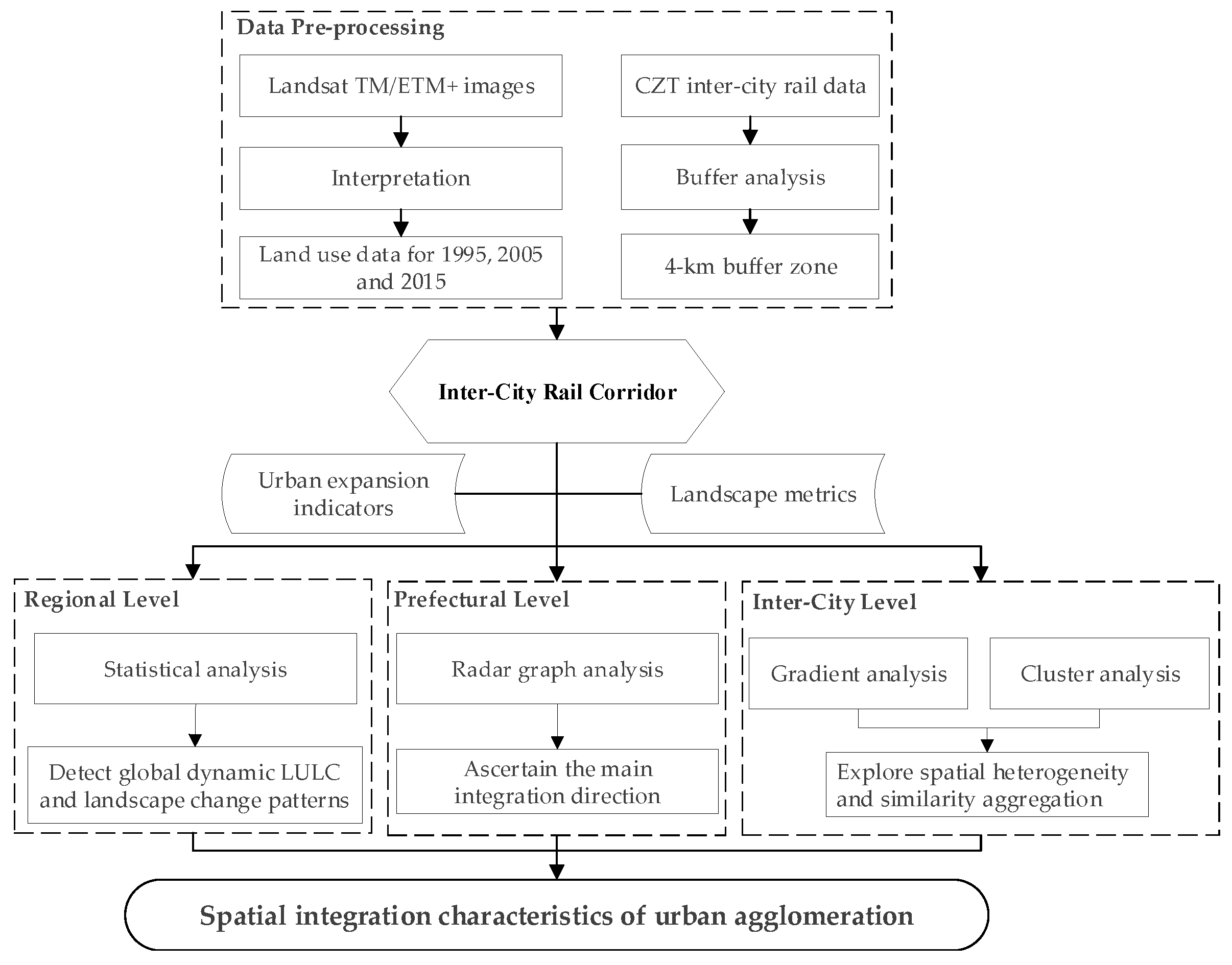
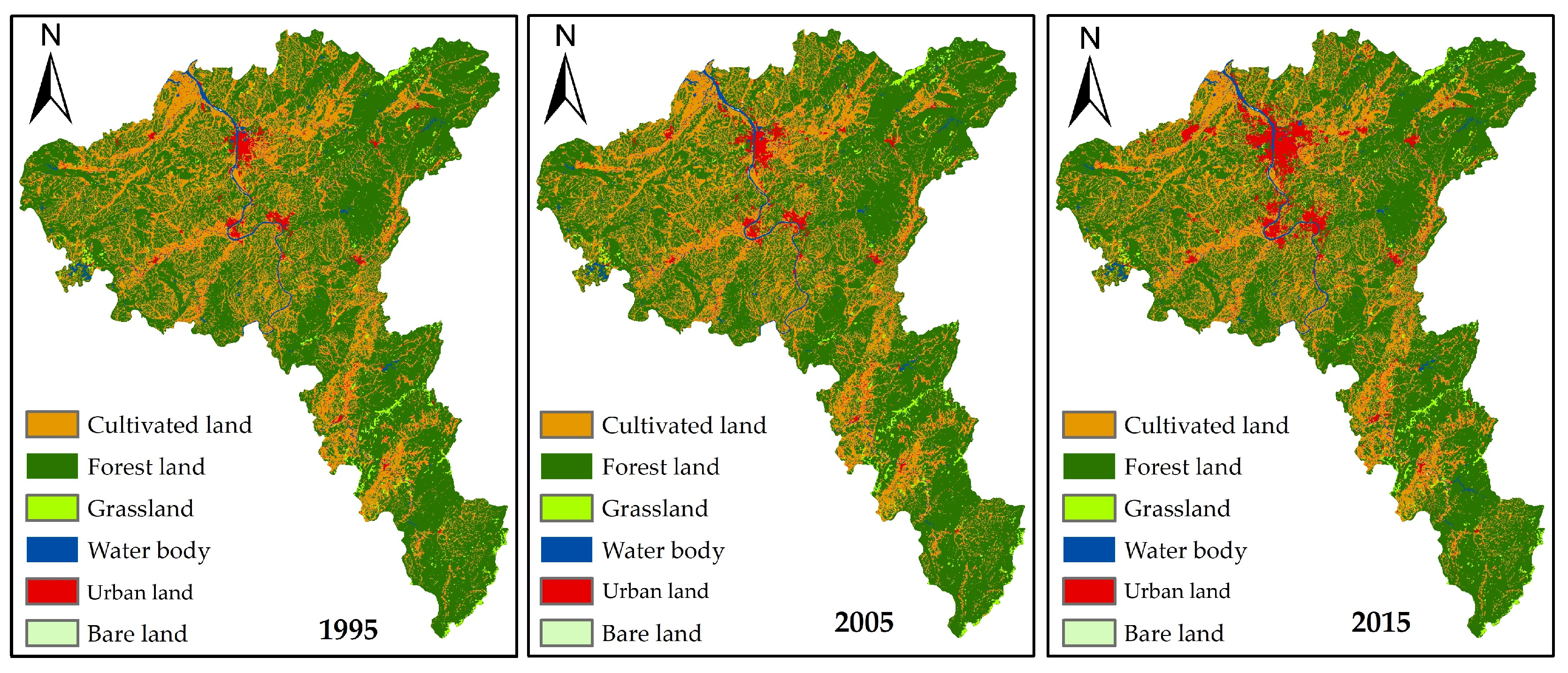
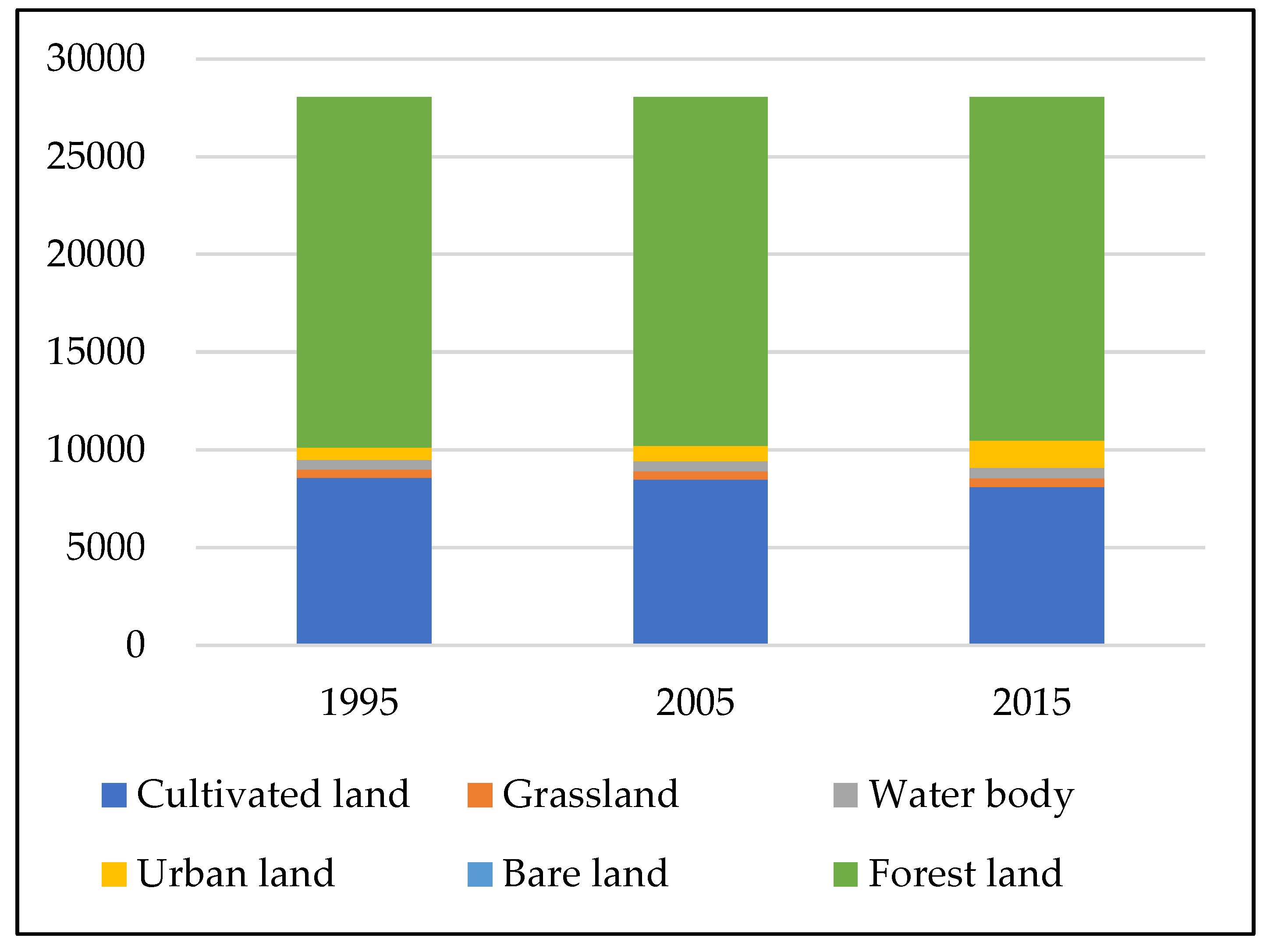
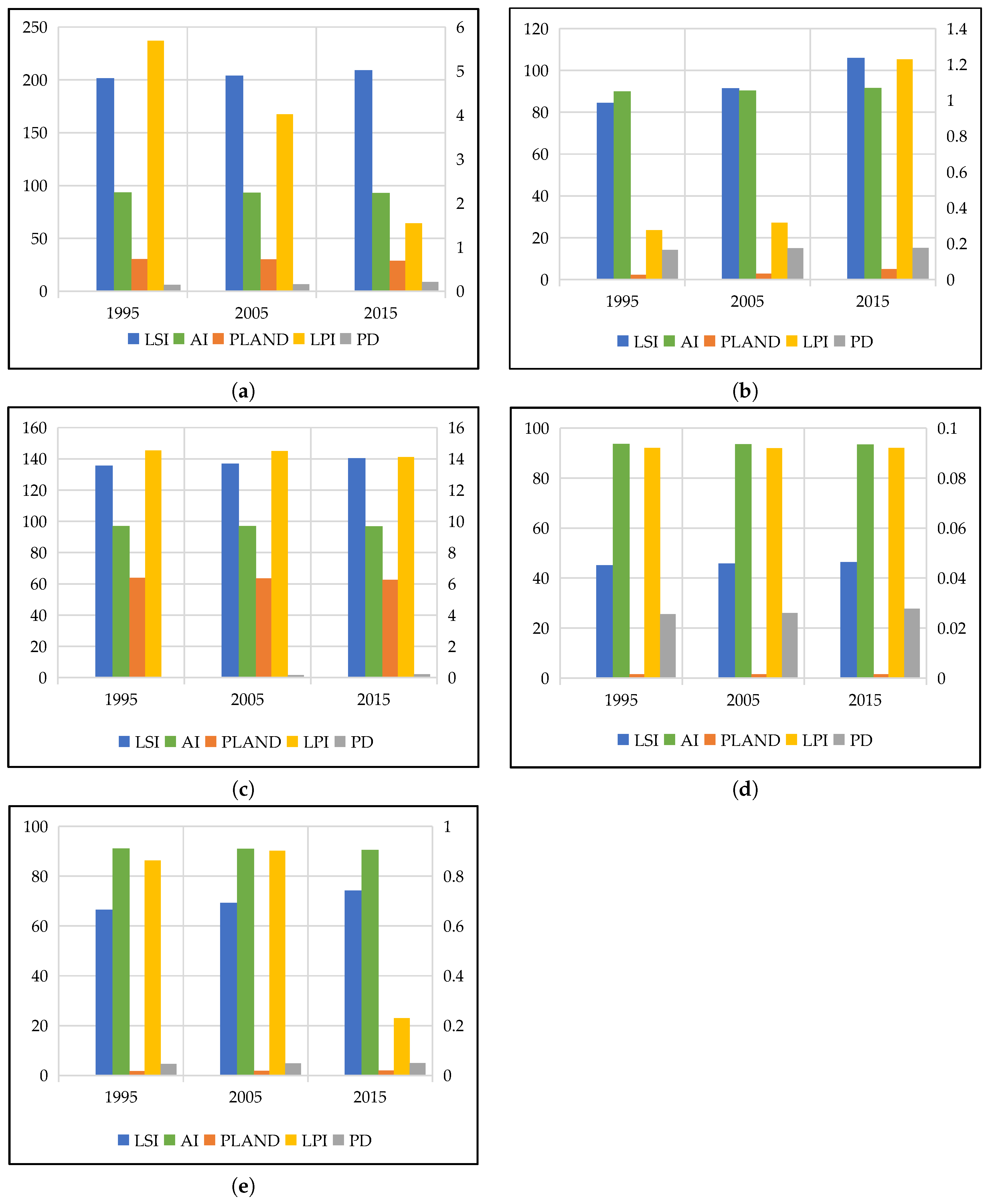
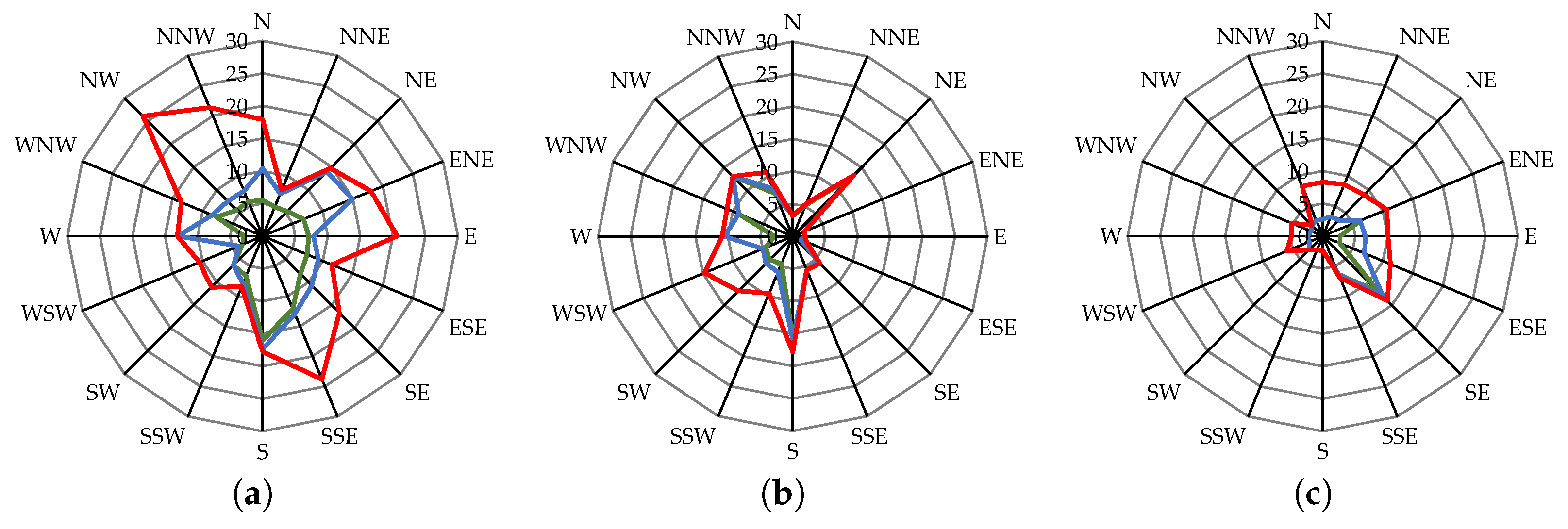
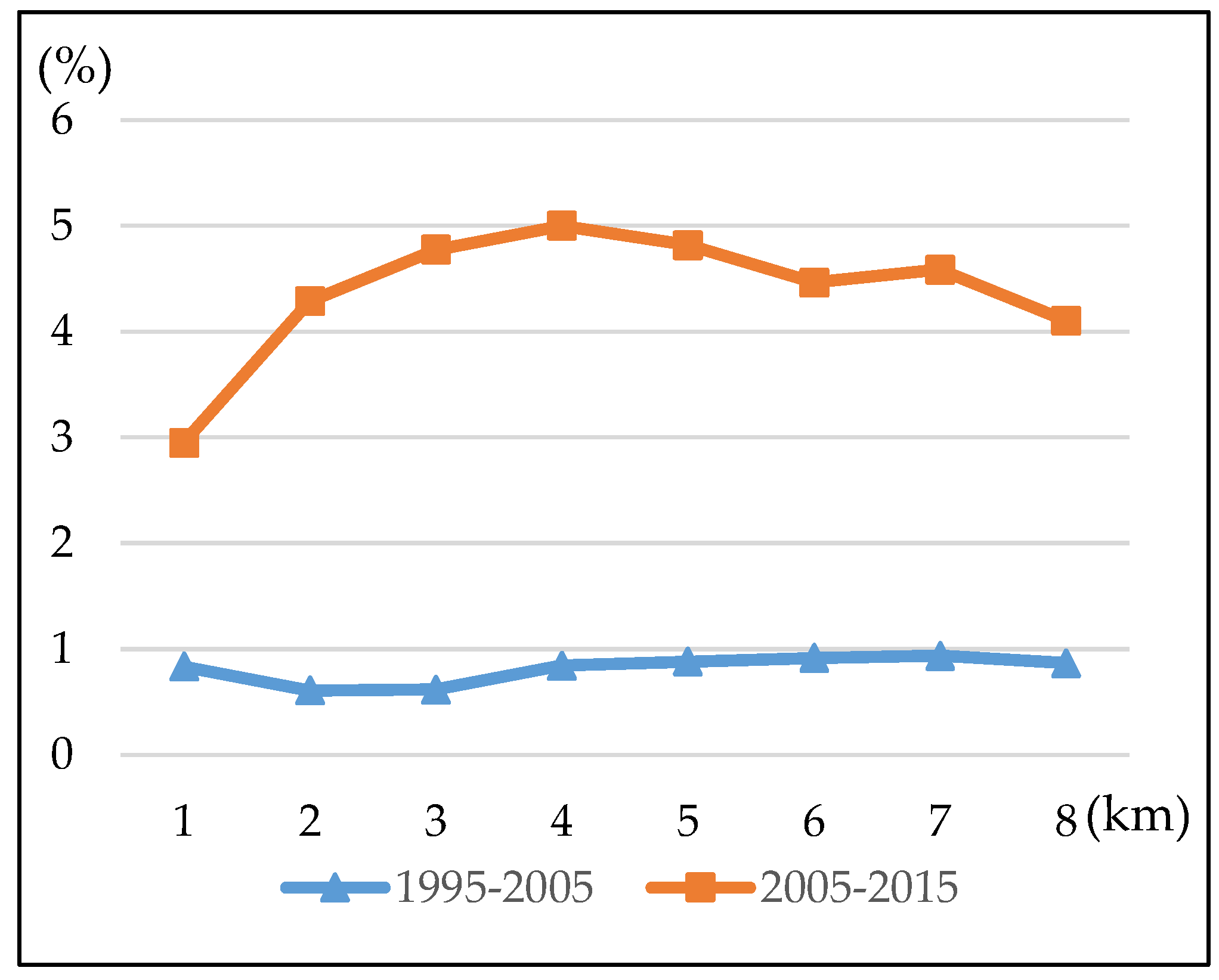
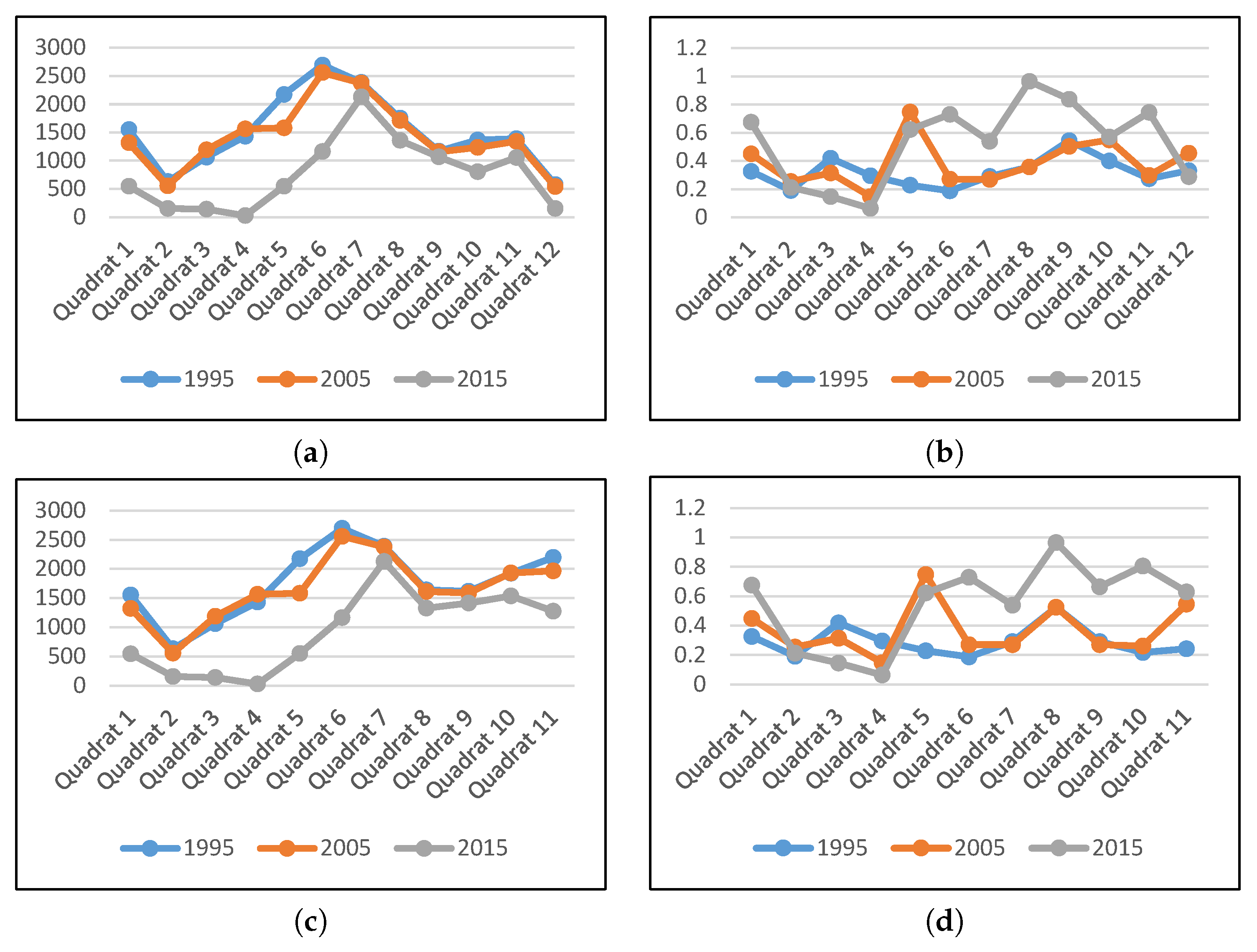
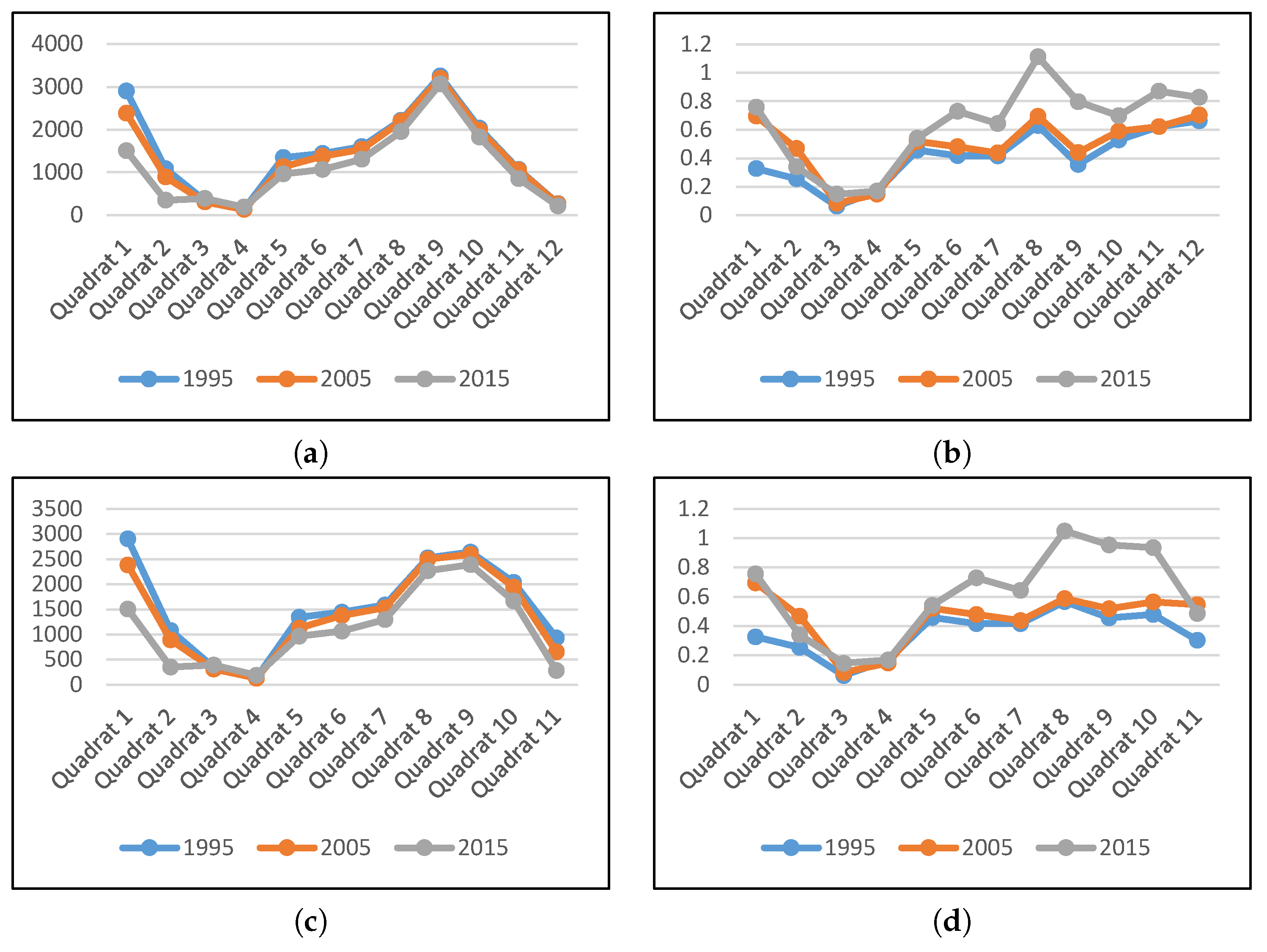
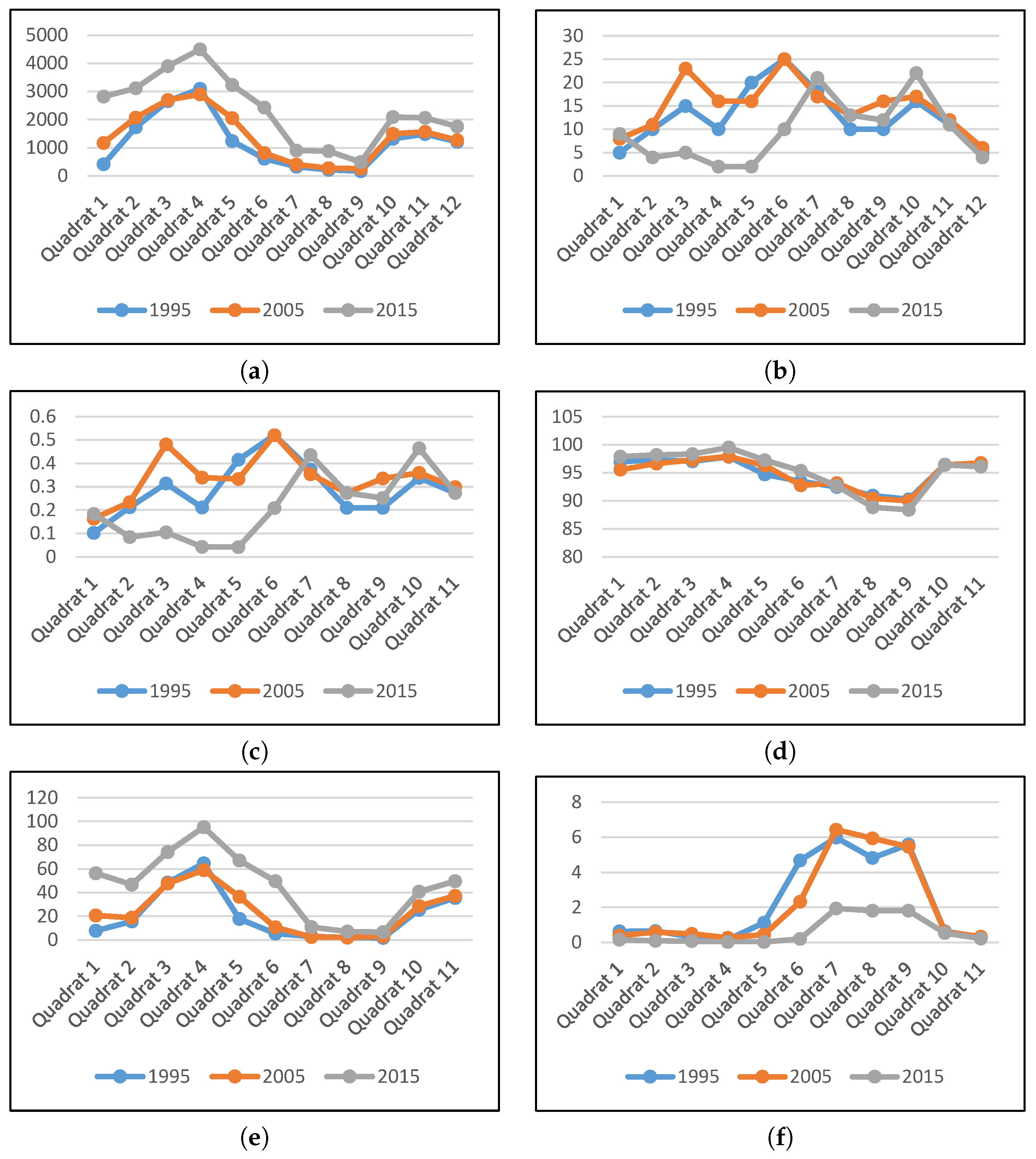

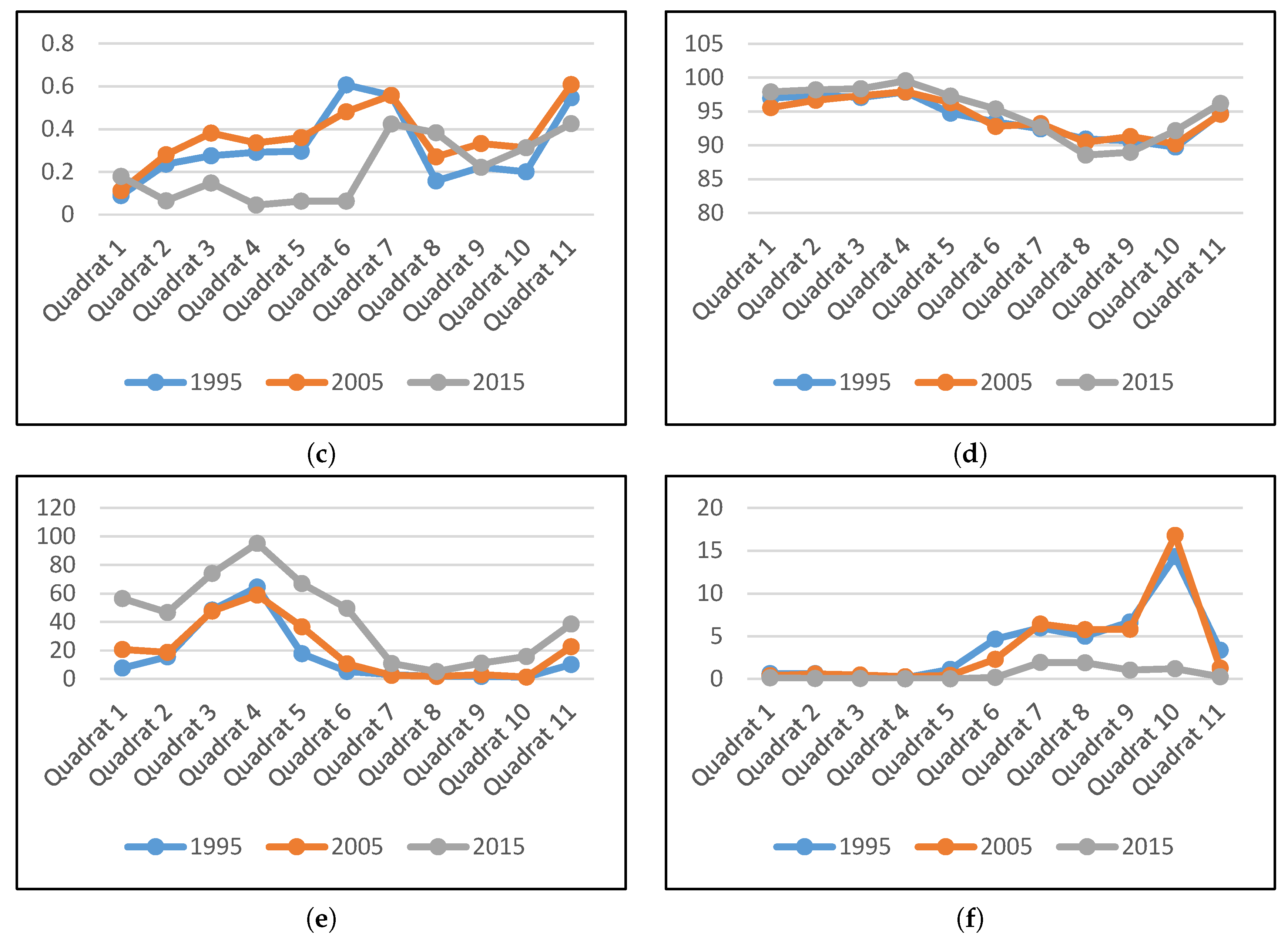
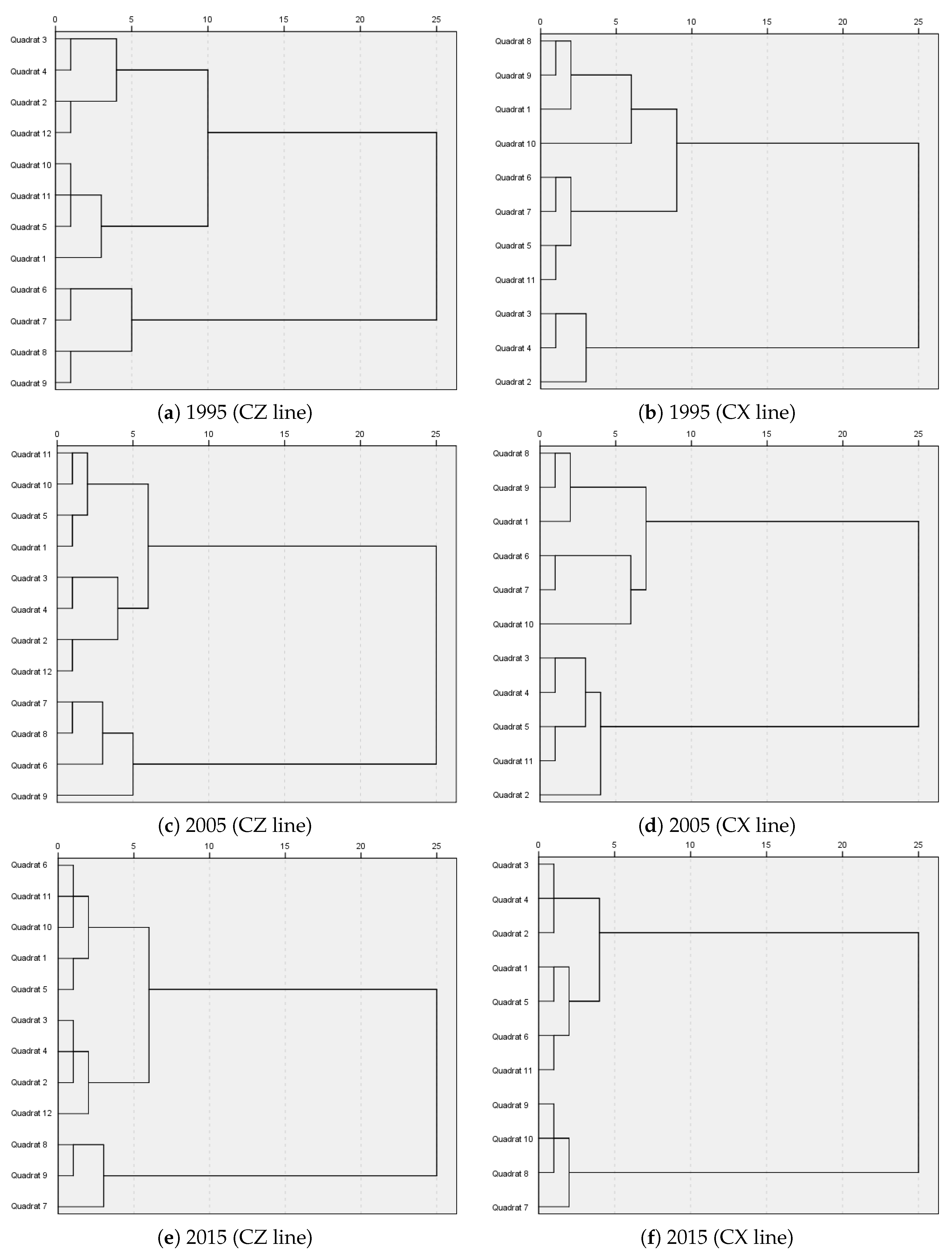
| Spatial Metric | Acronym | Description (Unit) |
|---|---|---|
| Percentage of Landscape | PLAND | Proportion of the total area occupied by a particular land use type (Percent). |
| Largest patch index | LPI | Percentage of the landscape comprised by the largest patch (Percent). |
| Landscape shape index | LSI | Total edge length in the landscape divided by the minimum total possible edge length. (None). |
| Patch density | PD | Number of patches per 100 ha of the corresponding patch type divided by the total landscape area (Number per 100 hectares). |
| Aggregation index | AI | Number of adjacent patches of the corresponding patch type based on the single-count method. (Percent). |
| City/Region | AER (%) | UEI (%) | ||||
|---|---|---|---|---|---|---|
| 1995–2005 | 2005–2015 | 1995–2015 | 1995–2005 | 2005–2015 | 1995–2015 | |
| Changsha | 3.3302 | 9.4169 | 7.9415 | 0.0856 | 0.3228 | 0.2042 |
| Zhuzhou | 1.7840 | 4.5936 | 3.5986 | 0.0334 | 0.1012 | 0.0673 |
| Xiangtan | 1.9437 | 7.6173 | 5.5207 | 0.0449 | 0.2103 | 0.1276 |
| CZT | 2.5578 | 7.5906 | 6.0450 | 0.0574 | 0.2139 | 0.1357 |
| Functional Type | CX Line | CZ Line | ||||
|---|---|---|---|---|---|---|
| 1995 | 2005 | 2015 | 1995 | 2005 | 2015 | |
| Urban center | 3, 4 | 3, 4 | 2, 3, 4 | 3, 4 | 3, 4 | 2, 3, 4, 12 |
| Urban area | 2 | 2 | 1, 5 | 2, 12 | 2, 12 | 1, 5 |
| Urban-rural fringe | 5, 11 | 5, 11 | 6,11 | 1, 5, 10, 11 | 1, 5, 10, 11 | 6, 10, 11 |
| Green core | 1, 6, 7, 8, 9, 10 | 1, 6, 7, 8, 9, 10 | 7, 8, 9, 10 | 6, 7, 8, 9 | 6, 7, 8, 9 | 7, 8, 9 |
© 2019 by the authors. Licensee MDPI, Basel, Switzerland. This article is an open access article distributed under the terms and conditions of the Creative Commons Attribution (CC BY) license (http://creativecommons.org/licenses/by/4.0/).
Share and Cite
Wan, Y.; Deng, C.; Wu, T.; Jin, R.; Chen, P.; Kou, R. Quantifying the Spatial Integration Patterns of Urban Agglomerations along an Inter-City Gradient. Sustainability 2019, 11, 5000. https://doi.org/10.3390/su11185000
Wan Y, Deng C, Wu T, Jin R, Chen P, Kou R. Quantifying the Spatial Integration Patterns of Urban Agglomerations along an Inter-City Gradient. Sustainability. 2019; 11(18):5000. https://doi.org/10.3390/su11185000
Chicago/Turabian StyleWan, Yiliang, Chuxiong Deng, Tao Wu, Rui Jin, Pengfei Chen, and Rong Kou. 2019. "Quantifying the Spatial Integration Patterns of Urban Agglomerations along an Inter-City Gradient" Sustainability 11, no. 18: 5000. https://doi.org/10.3390/su11185000
APA StyleWan, Y., Deng, C., Wu, T., Jin, R., Chen, P., & Kou, R. (2019). Quantifying the Spatial Integration Patterns of Urban Agglomerations along an Inter-City Gradient. Sustainability, 11(18), 5000. https://doi.org/10.3390/su11185000






